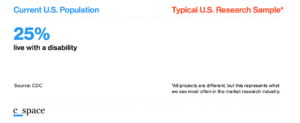Adjusting consumer research practices to account for a diversifying society
We ran a Better Why Peer Connection with insights leaders across industries to discuss how prioritizing the voices of customers we’ve underserved can help to future-proof your business. We learned that you and your leaders fundamentally agree this is necessary and possible, but may need help getting organization-wide buy-in. Here are key topics we discussed, and our take on how to make inclusive research a priority at your organization.
Not only are non-White racial and ethnic groups being undercounted in the US Census, but so are individuals identifying as LGBTQIA+.
1. Relying on the US Census for quotas doesn’t work
Undercounting is persistent, and worsening, for the US Census. According to the Brookings Institute, racial and ethnic minorities are significantly undercounted. Census population percentages have been what the market research industry has relied on for decades, but even an undercount of 3% of the Black population, for example, means missing data on more than 1 million people. The Latino undercount in 2020 was 3x the undercount in 2010.
Not only are non-White racial and ethnic groups being undercounted, but so are individuals identifying as LGBTQIA+. The Census only captures data for those that report they live in same-sex coupled households, missing a significant portion of diverse identities in the population.
Closeup of United States Census 2020 form below

Fortunately, trusted data sources exist who are able to give more accurate population estimates than the US Census, and we should start by striving to adjust our quotas to better align with these estimates. Even when your sample needs to be a specific subset of the US population, it’s important to first seek to understand the demographic makeup of that population.
For example, we often accept less racially/ethnically diverse samples for high net worth respondents, but sources like the Federal Reserve and Wells Fargo show that the wealth of Black and Hispanic individuals has been growing at a faster pace than wealth of White individuals. While the wealth gap still persists, it’s important to understand the changing landscape of wealth in the US and adapt our research practices so brands get the earliest consumer perception possible.
Inclusive insights GIF below

2. Centering people who have been pushed to the margins is profitable
We’re not afraid to say it—companies that prioritize diversity, equity and inclusion have already benefitted, are currently benefitting and will continue to benefit. In fact, new brands are entering crowded industries and succeeding because they are prioritizing consumers that have been deprioritized for so long.
Take Kin Apparel, for example. In 2021, they launched a hooded sweatshirt company—that’s right, a company centered around a product that has existed for nearly 100 years. One year later, the company’s net worth went from $200k to $1.5M. How? By centering the needs of Black consumers. Kin Apparel sells satin-lined hoodies (and now many other products) which appeals to the human truth that Black hair needs oil to thrive and regular hoodies cause dryness. It’s not a new trend that Kin Apparel profited from–it’s an existing consumer need that was uncovered with deep listening and intentional co-creating.
What opportunities for increased revenue might your organization be missing as a result of choosing not to adapt inclusive consumer research practices to address the needs of more consumers?
New brands are entering crowded industries and succeeding because they are prioritizing consumers that have been deprioritized for so long.
3. Inclusive research is more cost-effective
In addition to creating new revenue streams, hearing from more consumers also saves money. The argument against inclusive research is often the perception that it’s more expensive and/or takes longer. This perception is true when compared to conducting research the way we’ve been doing it, but now that we know that way is not representative, why would we compare to that?
Current market research practices aren’t as inclusive as they need to be and often result in poor data quality which leads brands to take action with a less informed approach. Some brands recognize that the approach is less informed and supplement with additional research projects that target one specific demographic. But imagine if projects were just inclusive from the beginning. Imagine if people with disabilities, for example, were included in the research the first time it was conducted. Brands like OXO would be the norm, rather than the exception.
Instead, our norm has become one worst-case scenario after another, resulting in brands spending non-budgeted dollars on product recalls, legal fees, new research and marketing spend, among other costs. In addition, revenue is lost.
In 2017, a global, billion-dollar beverage company aired a commercial in the US that failed with consumers. It was culturally insensitive and as a result, brand reception reached its lowest point in over eight years. In addition, the brand experienced a 3% decline in revenue that quarter and lower revenue that year in North America. All of this could have been avoided if representative voices were included in the market research that informed the commercial and larger marketing campaign.
It is easy to use the excuse of “needing to go fast” as a way to normalize not hearing from representative voices. Sometimes we need to slow down to “go faster.” By taking a little more time upfront in the research process to ensure your sample is truly representative, you can make stronger business decisions in a faster and more cost-effective way.

4. Most consumers and employees consider inclusion important
Prioritizing inclusion means happier, more loyal consumers and employees. For consumers, inclusion means more relatable advertisements, more relevant products and services, and more pride during cultural moments. For employees, inclusion means all of the above plus an opportunity to be creative and do work that feels meaningful.
This is not a fad or a trend that will disappear one day. Adults and children alike recognize the importance of belonging and inclusion and are more empowered than ever to make decisions based on a company’s commitment to inclusivity. While some brands and organizations are currently able to maintain profits even when ignoring Belonging & Inclusion, innovators like Kin Apparel will continue to disrupt markets and industries that seem impenetrable today with inclusive consumer data and insights.
Rather than be caught off guard by such innovation, why not prepare for it now? Applying an inclusive lens to market research is the first step to preparing your brand to meet the unaddressed needs of underserved consumer groups, and to incorporating this creativity into your product and service offerings.





